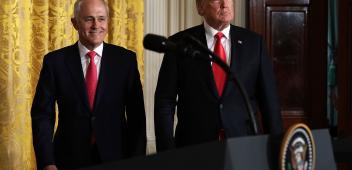Central bankers 'pushing on a string'
Originally published in the Nikkei Report.

Executive Summary
Central bankers from around the world met recently in Jackson Hole, Wyoming, for their annual long weekend get-together, with global monetary policy in a state of flux. Eight years after the 2008 financial crisis, historically low interest rate settings and adventurous "unconventional monetary policy" -- in the form of quantitative easing, forward guidance and negative interest rates -- have not been enough to restore inflation and output to normal levels. Both the U.S. Federal Reserve and the Bank of Japan will meet this week to consider further action, but their room for manoeuvre is quite limited.
Monetary policy has long been seen as less effective in promoting expansion than it is in restraining excessive demand -- "pushing on a string" is the usual analogy. In this recovery, however, it has been unexpectedly ineffectual. The policy interest rate in many advanced economies has been at or close to zero (or even below) for virtually the whole of the recovery, and yet inflation remains below target and the recovery remains lackluster.
Moreover, this "low-for-long" setting of interest rates is not just a phenomenon confined to the crisis-affected economies. These low interest rates have influenced interest rates (both short- and long-term) around the globe.
There are multiple causes for this lock-step pattern. Many countries find themselves in the trough of the business cycle; hence interest rates have been lowered for domestic reasons. In other cases, interest rates were lowered in order to avoid attracting foreign capital and thus raising exchange rates, which reduces international competitiveness. In other countries, rates have moved down because financial markets have become more integrated internationally, well on the way to becoming one huge interconnected global market.
Whatever the reason for the low interest rates, the result has been the same: Inflation has been unexpectedly low, given these expansionary monetary policy settings. This is true even in countries like Australia, New Zealand and the Asian emerging economies, none of which experienced a domestic financial crisis sufficient to cause strong "headwinds."
Opportunity or risk?
Low global interest rates and low inflation might seem to provide an opportunity for emerging Asian economies such as Indonesia to reach into global financial markets to fund infrastructure expansion. But the experience of the May 2013 "taper tantrum" is still seared in policy-makers' minds. Capital that had flowed in during the previous few years as investors sought a better return than they could get in the advanced economies left in a sudden flood triggered by the prospect of reductions in U.S. unconventional monetary easing, with alarming changes in bond yields and exchange rates.
These flows were responding to "risk-on/risk-off" changes in sentiment in global markets, which are largely beyond the control of emerging economy policy-makers. They know, too, that global financial markets are on tenterhooks, ready to overreact wildly to even minor adjustments of monetary policy. They note with concern the weekly arm-wrestle between the various members of the Fed's board, as the "hawks" skirmish with the "doves." They watch the equivalent tussles between the various members of the European Central Bank. There is not much assurance of smooth global financial markets here.
No-one knows how unconventional monetary policies will be unwound, but it is hard to see how the artificially low bond yields and distorted bank balance sheets can be restored to normality without significant market volatility, which will spill over into Asian markets, just as the "taper tantrum" did. Hardly surprising, then, that the reaction of central banks in emerging Asia has been one of great caution. The reaction has been entirely defensive: Interest rates have been lowered to avoid loss of international competitiveness, but this is not seen as an opportunity to go on a spending spree funded by low global borrowing rates.
This cautious approach may leave one beneficial longer-term legacy. Countries like Indonesia and India, which have tolerated chronic inflation rates significantly higher than their Asian peers, could use the opportunity of lower inflation to shift the public's inflation expectations down, anchoring them at a pace which matches the global notion of price stability.
This will be all the more important now that structural changes are likely to keep global inflation low. China's emergence as "manufacturer to the world" brought downward pressure on global prices. More generally, greater global integration has resulted in price-constraining competition. Every producer now faces potential price pressures from other parts of the supply chain, each eager to increase its share of the value-add.
Workers in this globalized world know that if their wage demands are excessive, production will shift elsewhere. Productivity-enhancing structural changes have reduced companies' pricing power and undermined wage-setting institutions. Corporate "financialization" (where the shareholders apply greater pressure on management for short-run performance) has added to pressures on pricing margins. The success of inflation-targeting in anchoring inflation expectations has played a role as well. These changes in price-setting have not been confined to the crisis-affected economies or even the advanced countries: They apply just about everywhere.
Having spent earlier decades painfully wringing inflation out of the system through the sort of crippling interest rates that then-Fed chairman Paul Volcker used in 1980 to get U.S. inflation down, it comes as a shock to central banks that the problem is not too much inflation, but too little, and that structural change, rather than their interest-rate setting, is calling the shots.
Why is this so? For monetary policy to be effectively expansionary in the face of weak demand and deflationary price pressures, the policy rate must be set low enough to encourage companies and households to borrow, bringing forward their expenditure and boosting demand. If, however, many people want to lend (lots of savers) and few want to borrow (not many compelling expenditure opportunities on offer), even a low policy rate will not boost demand. Should we call this "deficient demand" or follow the fashionable academic trend and dub it a low "neutral" interest rate? Whatever it is called, it means that monetary policy is, indeed, pushing on a string.
Markets and the BoJ
The strenuous efforts of the BoJ have managed to get inflation into positive territory, but Governor Haruhiko Kuroda's target of 2% inflation is still out of reach. The target also seems to be losing support, with a former BoJ board member advocating reducing it to 1%. The yen exchange rate has unwound all the initial depreciation which accompanied Prime Minister Shinzo Abe's appointment, and inflation expectations have eased back. Kuroda's speech at Jackson Hole still promised 2% inflation "at the earliest possible time," but markets have become skeptical.
Markets are now talking of the need for "helicopter money" -- fiscal expansion funded from the central bank's balance sheet. While this has strong support from some expert commentators, including the U.K. Financial Services Authority's former head Lord Turner, and the influential Financial Times economics commentator Martin Wolf, this is a measure of desperation when all else fails and conventional fiscal policy cannot be expanded. The International Monetary Fund's proposal of an incomes policy to raise wages in Japan seems an amazing suggestion from such a conservative organization, but it is a measure of the depth of pessimism that normal monetary policy -- or even unconventional monetary policy through quantitative easing -- can lift Japan out of its deflationary torpor.
As they meet on Sept. 21, the Fed and the BoJ are under pressure for more action -- to tighten a little in the case of the U.S., and apply more stimulus in the case of Japan. Small tweaks might satisfy the market's hunger for action, but there are no "silver bullets" that could restore the power of monetary policy. Rather than explore the far reaches of unconventional policy, the better approach is to recognize the inherent limitations in monetary policy when given the task of stimulating the economy. Central bank governors, whether the Fed's Janet Yellen or the BoJ's Kuroda, should not claim too much power for their policy instruments. With competence and some luck, central banks may be able to maintain inflation close to target in good times. But when the economy falls into a deep hole, monetary policy should not be expected to carry out the rescue alone.
Stephen Grenville is a nonresident fellow at the Lowy Institute for International Policy in Sydney and a former deputy governor of the Reserve Bank of Australia.



